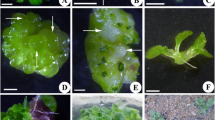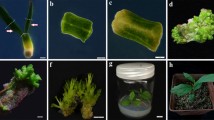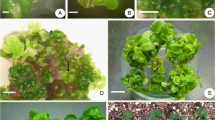Abstract
Simmondsia chinensis (Link) Schneider is a perennial, dioecious, drought resistant and multipurpose seed oil crop grown in arid and semi-arid conditions throughout the world. A reproducible and more efficient method for indirect shoot organogenesis from female leaf explants has been standardized. The leaf explants cultured on Murashige and Skoog (MS) medium with 1.0 mg l−1 2,4-dichlorophenoxyacetic acid (2,4-D) alone produced the highest frequency of callus compared with 1.5 mg l−1 IBA. Maximum proliferation of callus was observed on MS medium containing a combination of 1.0 mg l−1 2,4-D with 0.5 mg l−1 BAP. For shoot differentiation, the proliferated callus was subcultured on MS medium supplemented with 6-benzylaminopurine (BAP) (1.0–4.0 mg l−1) along with 40 mg l−1 adenine sulphate as additive or in combination with α-naphthalene acetic acid (NAA) or Indole-3-butyric acid (IBA). Optimum shoots differentiated from callus was obtained on MS medium supplemented with 2.0 mg l−1 BAP and 0.2 mg l−1 NAA. On this medium, 100 % cultures were responded with an average number of 14.44 shoots per explant with their mean length of 4.78 cm. In vitro rooting (6.22 roots per explant) was achieved on half strength MS medium containing 2 % sucrose with 3.0 mg l−1 IBA and 300 mg l−1 activated charcoal (AC). Rooted plantlets were successfully hardened under control conditions and acclimatized under field conditions with 90 % success rate. The present protocol is highly efficient, reproducible and economically viable for large scale production of female plants.

Similar content being viewed by others
References
Abbassy MA, Abdelgaleil SAM, Belal AH, Abdel Rasoul MAA (2007) Insecticidal, antifeedant and antifungal activities of two glucosides isolated from the seeds of Simmondsia chinensis. Ind Crop Prod 26:345–350
Agrawal V, Prakash S, Gupta SC (2002) Effective protocol for in vitro shoot production through nodal explants of Simmondsia chinensis. Biol Plant 45:449–453
Agrawal V, Sharma K, Gupta S, Kumar R, Prasad M (2007) Identification of sex in Simmondsia chinensis (Jojoba) using RAPD markers. Plant Biotechnol Rep 1:207–210
Ayerza R (2001) Wax-ester composition of ten jojoba clones growing in two arid ecosystems of South America. Trop Sci 41:167–171
Benzioni A, Ventura M (1998) Effect of phosphorus concentration in irrigation water on the development of jojoba cuttings. J Plant Nutr 21:2697–2706
Bhardwaj M, Uppal S, Jain S, Kharb P, Dhillon R, Jain RK (2010) Comparative assessment of ISSR and RAPD marker assays for genetic diversity analysis in jojoba [Simmondsia chinensis (Link) Schneider]. J Plant Biochem Biotechnol 19:255–258
Canoira L, Alcantara R, Garcia-Martinez MJ, Carrasco J (2006) Biodiesel from jojoba oil-wax: transesterification with methanol and properties as a fuel. Biomass Bioenergy 30:76–81
Catapan E, Marcio L, Silva B, Moreno FN, Viana AM (2002) Micropropagation, callus and root culture of Phyllanthus urinaria (Euphorbiaceae). Plant Cell Tissue Organ Cult 70:301–309
Chai M, Jia Y, Chen S, Gao Z, Wang H, Wang LP, Hou D (2011) Callus induction, plant regeneration, and long-term maintenance of embryogenic cultures in Zoysia matrella [L.] merr. Plant Cell Tissue Organ Cult 104:187–192
Champault A, Guérin B, Teller G (1985) Cytokinin contents and specific characteristics of tissue strains from three sexual genotypes of Mercurialis annua: evidence for sex gene involvement at callus-tissue level. Planta 166:429–437
Chawla HS (2002) Introduction to plant biotechnology (ed). Oxford & IBH publishing Co. Pvt. Ltd, New Delhi
Cheruvathur MK, Abraham J, Thomas TD (2013) Plant regeneration through callus organogenesis and true-to-type conformity of plants by RAPD analysis in Desmodium gangeticum (Linn) DC. Appl Biochem Biotechnol 169:1799–1810
Debnath B, Sinha S, Sinha RK (2013) Rapid in vitro differentiation and regeneration of Momordica dioica Roxb. Ind J Plant Sci 2:43–47
Deore AJ, Johnson TS (2008) High frequency plant regeneration from leaf-disc cultures of Jatropha curcas L.: an important biodiesel crop. Plant Biotechnol Rep 2:7–11
Gao HD, Cao B (2001) Study on technology of tissue culture of Simmondsia chinensis (Link) Schneider. J Jiangsu For Sci Technol 28:12–14
George EF, Hall MA, Klerk GJD (2008) Plant propagation by tissue culture (ed). Springer, Wageningen
Gorelicku R, Osborneb R (2002) lnducing sex change and organogenesis from tissue culture in the endangered African cycad Encephalartos woodii (Gycadales, Zamiaceael). South Afric J Sci 98:114–117
Guirguis OW, Abd Elkader MFH, Nasrat AA (2013) Enhancing antimicrobial activity for chitosan by adding Jojoba liquid wax. Mater Lett 93:353–355
Habashy RR, Abdel-Naim AB, Khalifa AE, Al-Azizi MM (2005) Anti-inflammatory effects of jojoba liquid wax in experimental models. Pharmacol Res 51:95–105
Ince AG, Karaca M, Onus AN (2010) A reliable gender diagnostic PCR assay for jojoba [Simmondsia chinensis (Link) Schneider]. Genet Resour Crop Evol 57:773–779
lrish EE, Nelson T (1989) Sex determination in monoecious and dioecious plants. Plant Cell 1:737–744
Koroch A, Juliani HR, Kapteyn J, Simon JE (2002) In vitro regeneration of Echinacea purpurea from leaf explants. Plant Cell Tissue Organ Cult 69:79–83
Kumar S, Mangal M, Dhawan AK, Singh N (2012) Biotechnological advances in jojoba [Simmondsia chinensis (Link) Schneider]: recent developments and prospects for further research. Plant Biotechnol Rep 6:97–106
Kumar S, Singh N, Mangal M (2009) Biochemical changes during shoot differentiation in callus cultures of Simmondsia chinensis (Link) Schneider. Plant Biol 36:1–6
Le Dréau Y, Dupuy N, Gaydou V, Joachim J, Kister J (2009) Study of jojoba oil aging by FTIR. Anal Chim Acta 642:163–170
Lee CW, Thomas JC (1985) Jojoba embryo culture and oil production. Hortic Sci 20:762–764
Llorente BE, Apostolo NM (1998) Effect of different growth regulators and genotypes on in vitro propagation of jojoba. New Zeal J Crop Hortic 26:55–62
Low CB, Hackett WP (1981) Vegetative propagation of jojoba. Calif Agric 35:12–13
Makunga NP, Jeger AK, Staden JV (2006) Improved in vitro rooting and hyperhydricity in regenerating tissues of Thapsia garganica L. Plant Cell Tissue Organ Cult 86:77–86
Mills D, Wenkart S, Benzioni A (1997) Micropropagation of Simmondsia chinensis (jojoba). In: Bajaj YPS (ed) Biotechnology in agriculture and forestry 40, high-tech and micropropagation VI. Springer-Verlag Berlin Heidelberg, New York, pp 370–393
Mohammed AM, Aly Essam A, Amer Wasef A, Al-Zayadneh AE, Negm E (2008) Growth regulators influence the fatty acid profiles of in vitro induced jojoba somatic embryos. Plant Cell Tissue Organ Cult 93:107–114
Murashige T, Skoog F (1962) A revised medium for rapid growth and bioassays with tobacco tissue culture. Physiol Plant 15:473–497
Naqvi HH, Ting IP (1990) Jojoba, unique liquid wax produces from the American desert. In: Janick J, Simen JE (eds) Advances in new crops. Climber Press, Portland, pp 247–251
Nirmal Babu K, Sajina KA, Minoo D, John CZ, Mini PM, Tushar KV (2003) Micropropagation of camphor tree (Cinnamomum camphora). Plant Cell Tissue Organ Cult 74:179–183
Phulwaria M, Shekhawat NS (2013) An efficient in vitro shoot regeneration from immature inflorescence and ex vitro rooting of Arnebia hispidissima (Lehm.). DC.-a red dye (alkannin) yielding plant. Physiol Mol Biol Plant 19:435–441
Prakash S, Agrawal V, Gupta SC (2003) Influence of some adjuvants on in vitro clonal propagation of male and female jojoba plants. In Vitro Cell Dev Biol Plant 39:217–222
Prem D, Singh S, Gupta PP, Singh J, Kadyan SPS (2005) Callus induction and de novo regeneration from callus in guar [Cyamopsis tetragonoloba L. Taub.]. Plant Cell Tissue Organ Cult 80:209–214
Rai GK, Singh M, Rai NP, Bhardwaj DR, Kumar S (2012) In vitro propagation of spine gourd (Momordica dioica Roxb.) and assessment of genetic fidelity of micropropagated plants using RAPD analysis. Physiol Mol Biol Plants 18:273–280
Radwan MS, Ismail MA, Elfeky SMS, Abu-Elyazeed OSM (2007) Jojoba methyl ester as a diesel fuel substitutes: preparation and characterization. Appl Therm Eng 27:314–322
Ranzato E, Martinotti S, Burlando B (2011) Wound healing properties of jojoba liquid wax: an in vitro study. J Ethnopharmacol 134:443–449
Rathore MS, Shekhawat NS (2013) In vitro regeneration in Sarcostemma acidum (Roxb.) -An important medicinal plant of semi-arid ecosystem of Rajasthan, India. Physiol Mol Biol Plant 19:269–275
Reddy MP, Chikara J (2010) Biotechnology advances in jojoba (Simmondsia chinensis). In: Ramawat KG (ed) Desert plants: biology and biotechnology. Springer-Verlag, Berlin
Roussos PA, Tolia-Marioli A, Pontikis CA, Kotsias D (1999) Rapid multiplication of jojoba seedlings by in vitro culture. Plant Cell Tissue Organ Cult 57:133–137
Sharma K, Agrawal V, Sarika G, Kumar R, Prasad M (2008) ISSR marker-assisted selection of male and female plants in a promising dioecious crop: jojoba (Simmondsia chinensis). Plant Biotechnol Rep 2:239–243
Sharma S, Kumar N, Reddy MP (2011) Regeneration in Jatropha curcas: factors affecting the efficiency of in vitro regeneration. Ind Crop Prod 34:943–951
Singh A, Reddy MP, Patolia JS (2008) An improved protocol for micropropagation of elite genotype of Simmondsia chinensis (link) Schneider. Biol Plant 52:538–542
Singh J, Tiwari KN (2010) High-frequency in vitro multiplication system for commercial propagation of pharmaceutically important Clitoria ternatea L.- a valuable medicinal plant. Ind Crop Prod 32:534–538
Thiruvengadam M, Praveen N, Lee Y, Chung I (2012) An efficient regeneration from petiole derived callus of male and female spine gourd (Momordica dioica Roxb, ex. Wild.). J Med Plant Res 6:3330–3337
Thomas TD (2008) The role of activated charcoal in plant tissue culture. Biotechnol Adv 26:618–631
Thomas TD, Philip B (2005) Thidiazuron-induced high frequency shoot organogenesis from leaf derived callus of a medicinal climber Tylophora indica (Burm. F.) Merrill. In Vitro Cell Dev Biol Plant 41:124–128
Thomas TD, Yoichiro H (2010) In vitro propagation for the conservation of a rare medicinal plant Justicia gendarussa Burm. f. by nodal explants and shoot regeneration from callus. Acta Physiol Plant 32:943–950
Zaher FA, El Kinawy OS, El Haron DE (2004) Solvent extraction of jojoba oil from pre-pressed jojoba meal. Grasas Aceites 55:129–134
Acknowledgments
Author (R.B.) gratefully acknowledges University Grant Commission (UGC), New Delhi, for the financial support in the form of Senior Research Fellowship (SRF). The authors are also thank to Mr. Rakesh kukkar, Thar nursery, Bikaner, India who provided plants of Simmondsia chinensis investigated under the present study.
Author information
Authors and Affiliations
Corresponding author
Rights and permissions
About this article
Cite this article
Bala, R., Beniwal, V.S. & Laura, J.S. An efficient and reproducible indirect shoot regeneration from female leaf explants of Simmondsia chinensis, a liquid-wax producing shrub. Physiol Mol Biol Plants 21, 293–299 (2015). https://doi.org/10.1007/s12298-015-0279-1
Received:
Revised:
Accepted:
Published:
Issue Date:
DOI: https://doi.org/10.1007/s12298-015-0279-1




